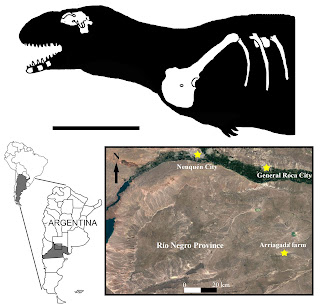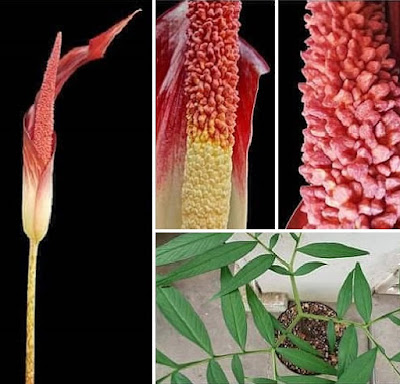[Most Recent Entries] [Calendar View]
Monday, November 9th, 2020
| Time | Event | ||
| 10:14a | [Paleontology • 2020] Niebla antiqua • A New medium-sized Abelisaurid (Theropoda, Dinosauria) from the late Cretaceous (Maastrichtian) Allen Formation of Northern Patagonia, Argentina Highlights: • A description of a new abelisaurid species from the Maastrichtian of Patagonia. • The publication of the mid-sized abelisaurid that represents one of the smallest of the group. • This specimen represents an adult specimen. • Phyllogenetically represents one of the most derived of the group. • Niebla reveals a more complex scenario for the abelisaurid evolution from the cretaceous of Patagonia. Abstract Abelisaurid theropods are well known in Cretaceous beds along South America, particularly Patagonia. However, the record of latest Cretaceous abelisauroids is still far from satisfactory. Until recently, few taxa were described from Maastrichtian beds: Carnotaurus sastrei and Quilmesaurus curriei, but also perhaps Abelisaurus comahuensis. In this contribution, we describe a new genus and species (Niebla antiqua gen. et sp. nov.), of medium-sized abelisaurid coming from Late Cretaceous (Maastrichtian) beds from Río Negro province, northern Patagonia, Argentina. The paleohistological analysis shows that this individual has reached the somatical maturity and that it represents an adult of a mid-sized abelisaurid. The specimen is represented by a nearly complete braincase, fragmentary jaw and teeth, relatively complete scapulocoracoid, dorsal ribs and incomplete vertebrae. The new taxon is relatively small, much smaller than other coeval abelisaurids such as Carnotaurus and Abelisaurus. The braincase shows autapomorphic features such a dorsoventrally tall basal tuber and postemporal foramen enclosed by parietal and exoccipitals. The scapulocoracoid is notably similar to that of Carnotaurus in having a posterodorsally oriented glenoid, a dorsoventrally expanded and wide coraco-scapular plate, and a very narrow and straight scapular blade. These features are very different from those of other abelisaurids, which may indicate a unique conformation of the pectoral girdle among these South American theropods. Keywords: Abelisauridae, Maastrichtian, South America, Paleohistology, Phylogeny, Endocranial morphology SYSTEMATIC PALAEONTOLOGY Theropoda Marsh, 1881 Ceratosauria Marsh, 1884 Abelisauroidea Bonaparte, 1991 Abelisauridae Bonaparte and Novas, 1985 Niebla antiqua gen. et sp. nov. Derivation of name. Niebla, from the Spanish “mist” in reference to the foggy days during the excavation of the specimen; antiqua, comes from the Latin “old” and makes reference to the age of the specimen. Type locality. Cerro Matadero (...), Arriagada Farm, located 70 km south from General Roca city, Río Negro province, Argentina. Mauro Aranciaga Rolando, Mauricio A. Cerroni, Jordi A. Garcia Marsà, Federico l. Agnolín, Matías J. Motta, Sebastián Rozadilla, Federico Brisson Eglí and Fernando E. Novas. 2020. A New medium-sized Abelisaurid (Theropoda, Dinosauria) from the late Cretaceous (Maastrichtian) Allen Formation of Northern Patagonia, Argentina. Journal of South American Earth Sciences. 102915 In Press. DOI: 10.1016/j.jsames.2020.102915 | ||
| 10:27a | [Botany • 2020] Amorphophallus ardii (Araceae: Aroideae) • A New Species of Amorphophallus from Sulawesi, Indonesia
Abstract Amorphophallus ardii is described and illustrated, and compared to other Indonesian Amorphophallus species. The species was collected in the Matarombeo limestone mountain range in Southeast Sulawesi, Indonesia. The species is restricted to karst areas and endemic to Southeast Sulawesi. Keywords: Amorphophallus ardii, endemic, Endangered, Indonesian flora, Southeast Sulawesi, Monocots Amorphophallus ardii Yuzammi and Wilbert Hetterscheid. 2020. A New Species of Amorphophallus (Araceae—Thomsoniaea) from Sulawesi, Indonesia. Phytotaxa. 461(4); 295–300. DOI: 10.11646/phytotaxa.461.4.6 instagram.com/p/CGHlDKYjbG5 wisnu.ardi83 |
| << Previous Day |
2020/11/09 [Calendar] |
Next Day >> |






